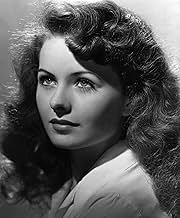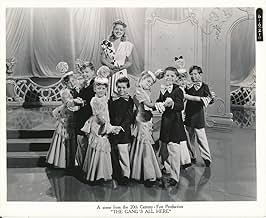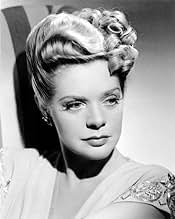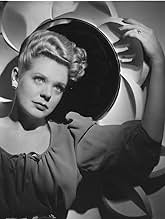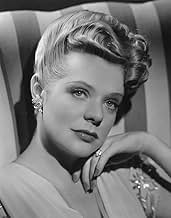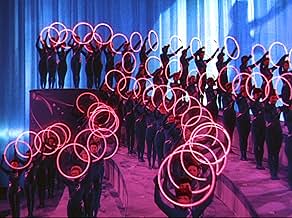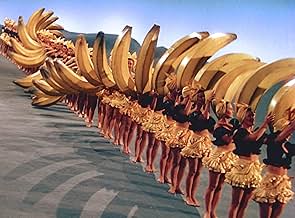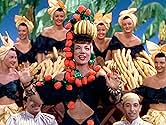IMDb रेटिंग
6.6/10
2.2 हज़ार
आपकी रेटिंग
अपनी भाषा में प्लॉट जोड़ेंA soldier falls for a chorus girl and then experiences trouble when he is posted to the Pacific.A soldier falls for a chorus girl and then experiences trouble when he is posted to the Pacific.A soldier falls for a chorus girl and then experiences trouble when he is posted to the Pacific.
- 1 ऑस्कर के लिए नामांकित
- 2 जीत और कुल 1 नामांकन
Benny Goodman and His Orchestra
- Benny Goodman's Orchestra
- (as Benny Goodman Orchestra)
Don Anderson
- Club New Yorker Patron
- (बिना क्रेडिट के)
Leon Belasco
- Waiter
- (बिना क्रेडिट के)
Brooks Benedict
- Club New Yorker Patron
- (बिना क्रेडिट के)
Lee Bennett
- Club New Yorker Patron
- (बिना क्रेडिट के)
William A. Boardway
- Club New Yorker Patron
- (बिना क्रेडिट के)
फ़ीचर्ड समीक्षाएं
There are films whose plots are much worse. At least this film has funny moments with Charlotte Greenwood and whenever Carmen Miranda is on the screen.
But this film is a showcase for the two sequences choreographed by Busby Berkeley. Much has been written about them, but watching them never ceases to stimulate and amaze my senses. Berkeley's sense of space is so elastic -- you feel as if he could pan and zoom through miles of space and fill it with people, trees, bananas, anything! I don't think any of his Warner Bros. films used the zoom camera with as much daring (supposedly Carmen Miranda almost got knocked off the painted donkey during rehearsals of "The Lady in the Tutti-Frutti Hat").
What is so special for me in these dance sequences is that the images and music are so well-constructed that you loose interest in following the plot and just revel and enjoy the images. People cease being human forms and become elements of color on a painted canvas, and then resume being human once again. It's all incredibly magical and more abstract than Berkeley had been or was able to achieve in the future. Stunning!
But this film is a showcase for the two sequences choreographed by Busby Berkeley. Much has been written about them, but watching them never ceases to stimulate and amaze my senses. Berkeley's sense of space is so elastic -- you feel as if he could pan and zoom through miles of space and fill it with people, trees, bananas, anything! I don't think any of his Warner Bros. films used the zoom camera with as much daring (supposedly Carmen Miranda almost got knocked off the painted donkey during rehearsals of "The Lady in the Tutti-Frutti Hat").
What is so special for me in these dance sequences is that the images and music are so well-constructed that you loose interest in following the plot and just revel and enjoy the images. People cease being human forms and become elements of color on a painted canvas, and then resume being human once again. It's all incredibly magical and more abstract than Berkeley had been or was able to achieve in the future. Stunning!
Something between a fever-dream and a screwball comedy, THE GANG'S ALL HERE is the Fox Musical at its most extravagant. With everthing from Charlotte Greenwood doing her trademarked high-kick routine to Carmen Miranda in a ten-story banana headdress, there's never a dull moment (that might let you concentrate too closely on the plot, which can most charitably be described as serviceable). The picture is a carnival of character bits, ridiculous shtick, and mind-boggling transitions. Edward Everett Horton gets covered with Carmen's lipstick and claims it's ketchup -- "Yes, and from a Brazilian tomato!" ripostes his wife (Greenwood, who really is terrific here). Eugene Pallette growls "Don't be a square from Delaware!" when he wants his pal Horton to get hep and join in the latest dance sensation. A New York nightclub has a stage large enough for what looks like all of a tropical island (for Carmen's immortal "Lady in the Tutti-Frutti Hat" number, truly a Freudian nightmare), and a number set in a Westchester backyard features more trick fountains than two Esther Williams epics.
In the end, it all just stops, with a 30-second plot resolution ("oh, yes, didn't I tell you? He's loved you all along!" or some such) in order to make room for the finale, the most dizzying number yet: a paean to the polka-dot (featuring Alice Faye's most effortful emoting ever on the line "...But the Polka Dot...Lives...On!") that segues into a ballet featuring neon hoops, vast rolling dots, kaleidoscopic trick photography, and, finally, an endearingly primitive blue-curtain effect that shows the heads of all the principals (and hundreds of chorus girls) bouncing along to a reprise of the hit ballad "A Journey to a Star." Well, THE GANG'S ALL HERE may not be quite that, but it's certainly a journey into a different era in filmmaking.
In the end, it all just stops, with a 30-second plot resolution ("oh, yes, didn't I tell you? He's loved you all along!" or some such) in order to make room for the finale, the most dizzying number yet: a paean to the polka-dot (featuring Alice Faye's most effortful emoting ever on the line "...But the Polka Dot...Lives...On!") that segues into a ballet featuring neon hoops, vast rolling dots, kaleidoscopic trick photography, and, finally, an endearingly primitive blue-curtain effect that shows the heads of all the principals (and hundreds of chorus girls) bouncing along to a reprise of the hit ballad "A Journey to a Star." Well, THE GANG'S ALL HERE may not be quite that, but it's certainly a journey into a different era in filmmaking.
It was called "The Girls He Left Behind", when first released in Britain in 1944. In this movie I think Busby Berkeley reached the pinnacle. It was his finest effort. Carmen Miranda, wearing that tutti frutty hat was a mouth-watering revelation; along with her ability to murder the English language. Roly poly Eugene Palette, trying to get the worrisome Edward Everett Horton's mind off his wife. Handing their hats to the hat-check girl, who was the lovely June Haver. (If you blinked you would have missed her). Alice Faye? A dream in Technicolour. James Ellison in the leading romantic role. Where was John Payne? He was the usual romantic lead in these Twentieth Century Fox musical capers of the early nineteen-forties.
Weak plot? Who the hell really cared! The Benny Goodman Orchestra; those songs, and the rich Technicolour, plus the Lanky Charlotte Greenwood, blindly reaching for the telephone and answering with the cat instead, brightened this teen-aged English boy's life in those wartime years of long ago. I have watched it on television more than once. The big question though. Why oh why, has it not been released on video or, better still, DVD? Can anyone explain?
Weak plot? Who the hell really cared! The Benny Goodman Orchestra; those songs, and the rich Technicolour, plus the Lanky Charlotte Greenwood, blindly reaching for the telephone and answering with the cat instead, brightened this teen-aged English boy's life in those wartime years of long ago. I have watched it on television more than once. The big question though. Why oh why, has it not been released on video or, better still, DVD? Can anyone explain?
... from 20th Century Fox and director Busby Berkeley. The meager plot concerns Army sergeant on leave Andy Mason (James Ellison) who falls for nightclub performer Edie Allen (Alice Faye). The only problem is that Andy's already engaged to Vivian Potter (Sheila Ryan). Edie's flamboyant friend and co-worker Dorita (Carmen Miranda) tries to help, to mixed results. Also featuring Eugene Pallette, Edward Everett Horton, Phil Baker, Charlotte Greenwood, Tony De Marco, Dave Willock, Frank Faylen, June Haver and Jeanne Crain in their debuts, and Benny Goodman and His Orchestra.
The plot is naturally secondary to the musical numbers, several of which are bizarre, most notably "The Lady in the Tutti Frutti Hat", featuring chorus girls running around with giant bananas. Berkeley's camera moves around, under and above the action, shattering the pretense that these numbers are designed for a nightclub or theatrical audience, taking them strictly into the realm of cinema. The costumes are also eye-popping, even those worn in the non-musical scenes, and Miranda wears an assortment of outlandish hats. This marked the end of Alice Faye's star period. She had a cameo in the following year's Four Jills in a Jeep, and then a non-musical part in 1945's Fallen Angel, before entering into screen retirement for 17 years. The movie earned an Oscar nomination for Best Color Art Direction.
The plot is naturally secondary to the musical numbers, several of which are bizarre, most notably "The Lady in the Tutti Frutti Hat", featuring chorus girls running around with giant bananas. Berkeley's camera moves around, under and above the action, shattering the pretense that these numbers are designed for a nightclub or theatrical audience, taking them strictly into the realm of cinema. The costumes are also eye-popping, even those worn in the non-musical scenes, and Miranda wears an assortment of outlandish hats. This marked the end of Alice Faye's star period. She had a cameo in the following year's Four Jills in a Jeep, and then a non-musical part in 1945's Fallen Angel, before entering into screen retirement for 17 years. The movie earned an Oscar nomination for Best Color Art Direction.
20th Century Fox pulled out all the stops for this Technicolor musical, "The Gang's All Here," directed by Busby Berkeley. There is a song at least every few minutes, wonderful singing, dancing, and comedy galore, and an absolutely threadbare plot. The story is of no consequence - the music is the thing, along with Carmen Miranda's gaudily-costumed numbers and delightful butchering of the English language.
This film was made to bolster spirits during the war and to sell war bonds, which is dealt with in part of the plot. I can't imagine anyone walking out of the theater with anything but a smile on their face.
Alice Faye is lovely and sings beautifully in her contralto, her main number being "A Journey to a Star." Miranda's big number, of course, is the classic "The Lady in the Tutti Frutti Hat" with the fabulous illusion at the end. Charlotte Greenwood gets to dance in "The Jitters" and she, Edward Everett Horton, and Eugene Palette provide excellent support. Benny Goodman's band is a standout, and I've always been a sucker for Benny's smooth, relaxed singing voice. Busby Berkeley's numbers are spectacular, particularly the finale - but somehow, I can't see it being done on someone's lawn! I agree with one of the posters, these Fox musicals need to be packaged into a collection and put out on DVD. They're too much fun to miss.
This film was made to bolster spirits during the war and to sell war bonds, which is dealt with in part of the plot. I can't imagine anyone walking out of the theater with anything but a smile on their face.
Alice Faye is lovely and sings beautifully in her contralto, her main number being "A Journey to a Star." Miranda's big number, of course, is the classic "The Lady in the Tutti Frutti Hat" with the fabulous illusion at the end. Charlotte Greenwood gets to dance in "The Jitters" and she, Edward Everett Horton, and Eugene Palette provide excellent support. Benny Goodman's band is a standout, and I've always been a sucker for Benny's smooth, relaxed singing voice. Busby Berkeley's numbers are spectacular, particularly the finale - but somehow, I can't see it being done on someone's lawn! I agree with one of the posters, these Fox musicals need to be packaged into a collection and put out on DVD. They're too much fun to miss.
क्या आपको पता है
- ट्रिवियाThe production number "The Lady In The Tutti-Frutti Hat" ran into problems with the censors. The Hayes office at first considered the way the gigantic bananas were held in front of the dancers as being too "phallic". The problem was resolved by having the dancers hold the bananas at waist level rather than at hip level.
- गूफ़Incorrectly regarded as goof: As the passengers disembark the ship within the first 3 minutes of the film, a series of mechanical-looking large shadows can be easily seen moving across the painted backdrop of buildings intended to be far in the distance. This is actually a stage set of a musical production, thus not filmed as a real scene.
- भाव
Phil Baker: Oh, Dorita, you remember Mr. Potter and Mr. Mason.
Dorita: Ah! I remember Mr. Potty. You are here to kick up some more heels, huh?
Peyton Potter: No!
Phil Baker: Mr. Potter wants you to come to his house this weekend.
Dorita: Ah-ah-ah, you naughty boy. You are what they call a fast-work man, yes?
- कनेक्शनEdited into Myra Breckinridge (1970)
- साउंडट्रैकHail! Hail! The Gang's All Here!
(uncredited)
Music by Theodore Morse and Arthur Sullivan
Lyrics by Dolly Morse (as D.A. Esrom)
Sung by a chorus during the opening credits
टॉप पसंद
रेटिंग देने के लिए साइन-इन करें और वैयक्तिकृत सुझावों के लिए वॉचलिस्ट करें
- How long is The Gang's All Here?Alexa द्वारा संचालित
विवरण
- रिलीज़ की तारीख़
- कंट्री ऑफ़ ओरिजिन
- भाषाएं
- इस रूप में भी जाना जाता है
- The Girls He Left Behind
- फ़िल्माने की जगहें
- उत्पादन कंपनी
- IMDbPro पर और कंपनी क्रेडिट देखें
- चलने की अवधि
- 1 घं 43 मि(103 min)
- रंग
- पक्ष अनुपात
- 1.33 : 1
इस पेज में योगदान दें
किसी बदलाव का सुझाव दें या अनुपलब्ध कॉन्टेंट जोड़ें


